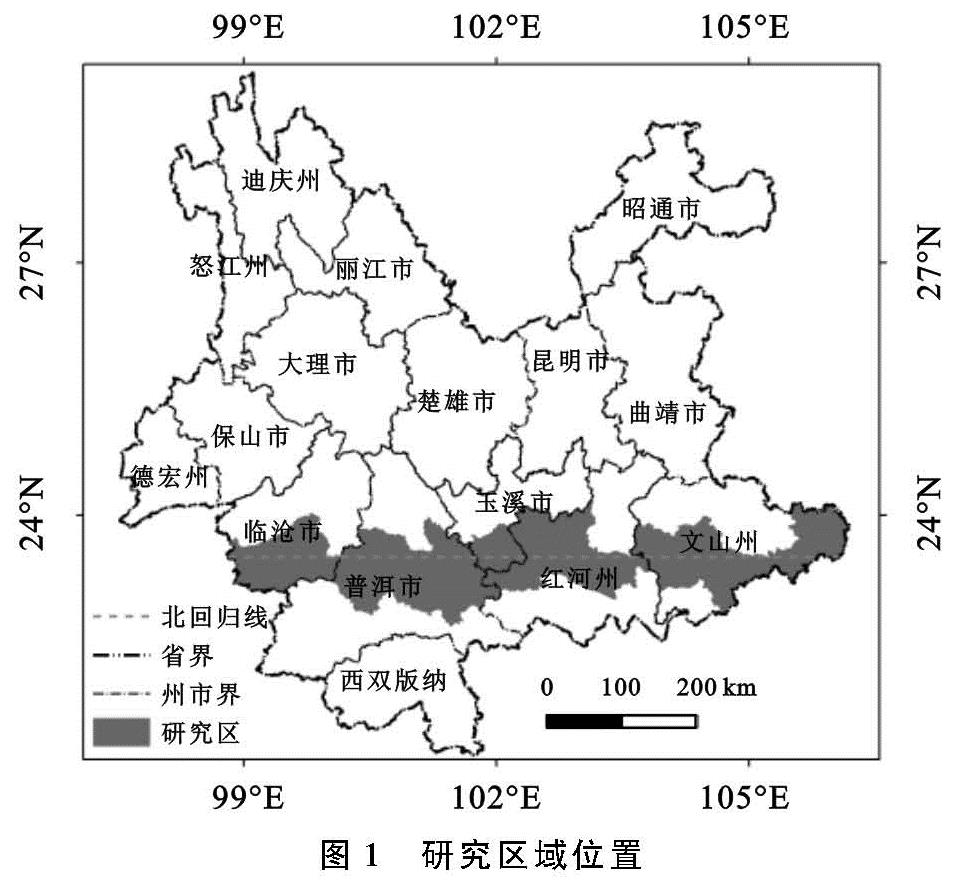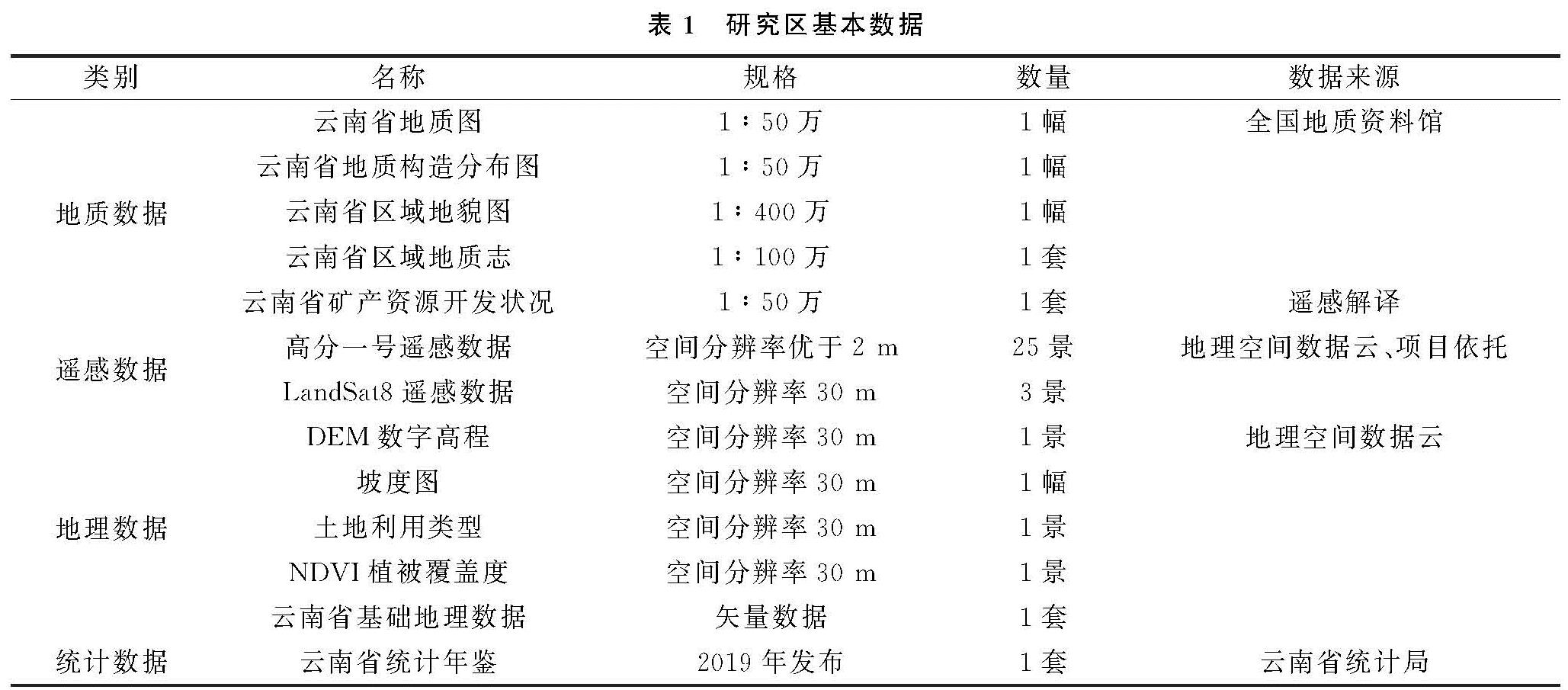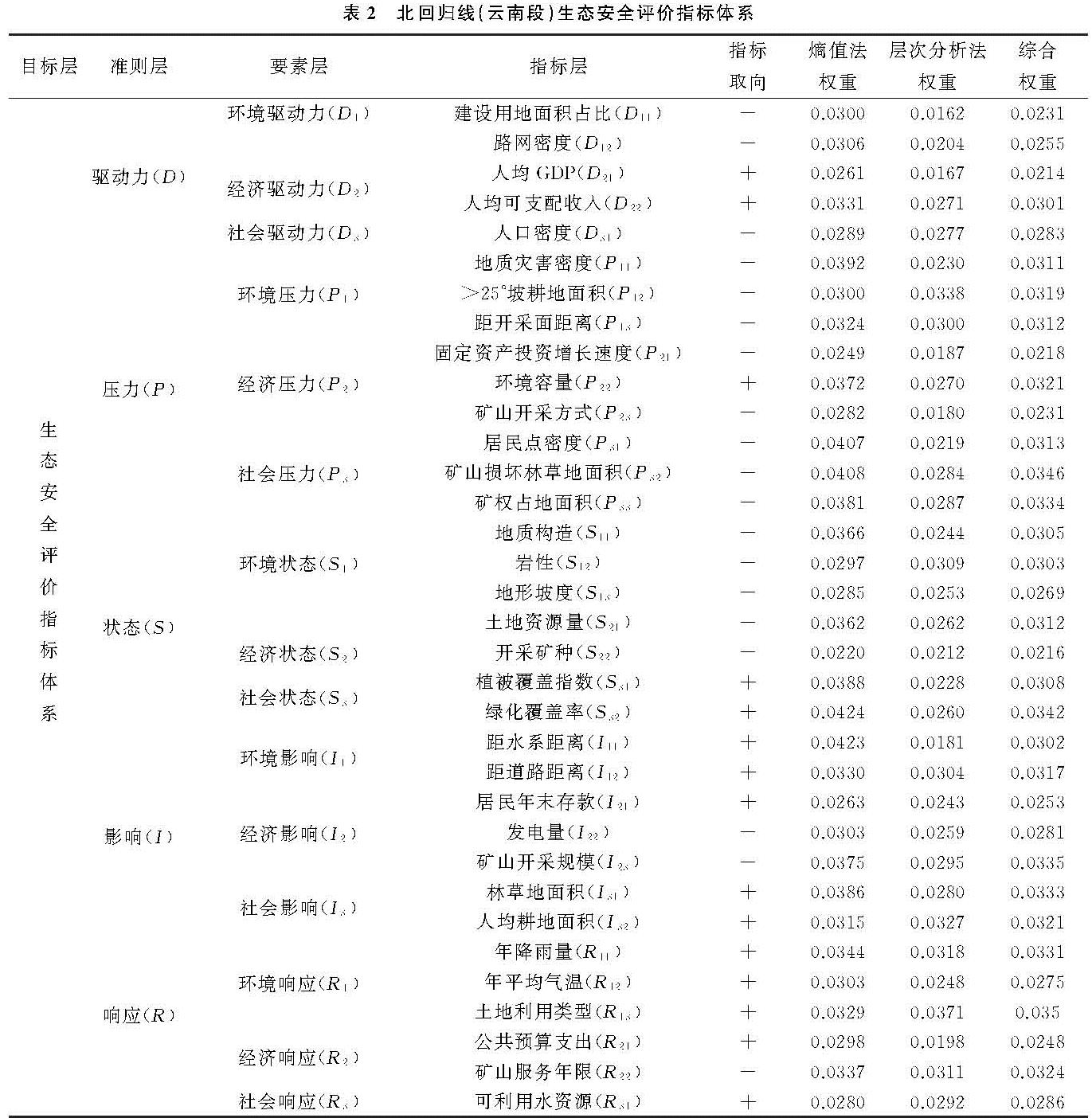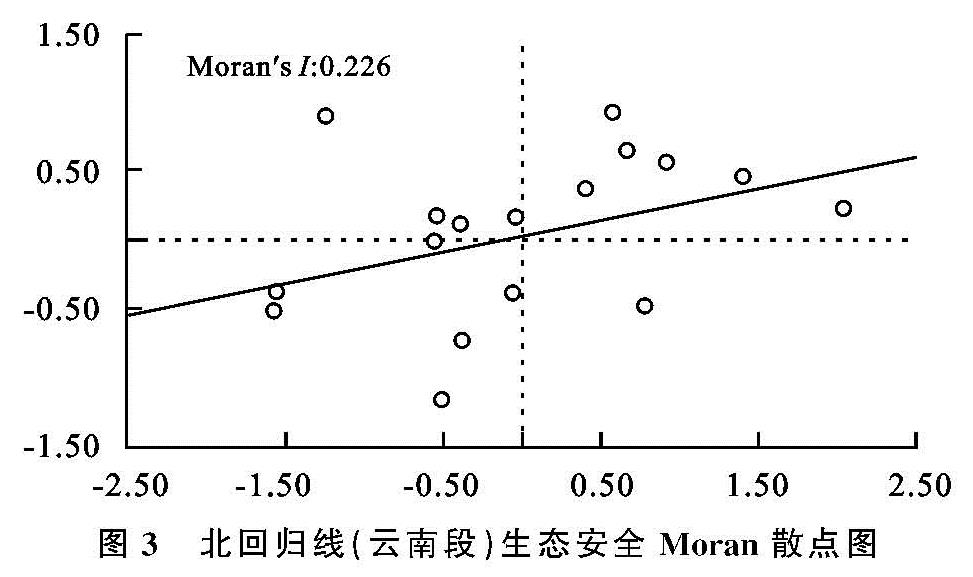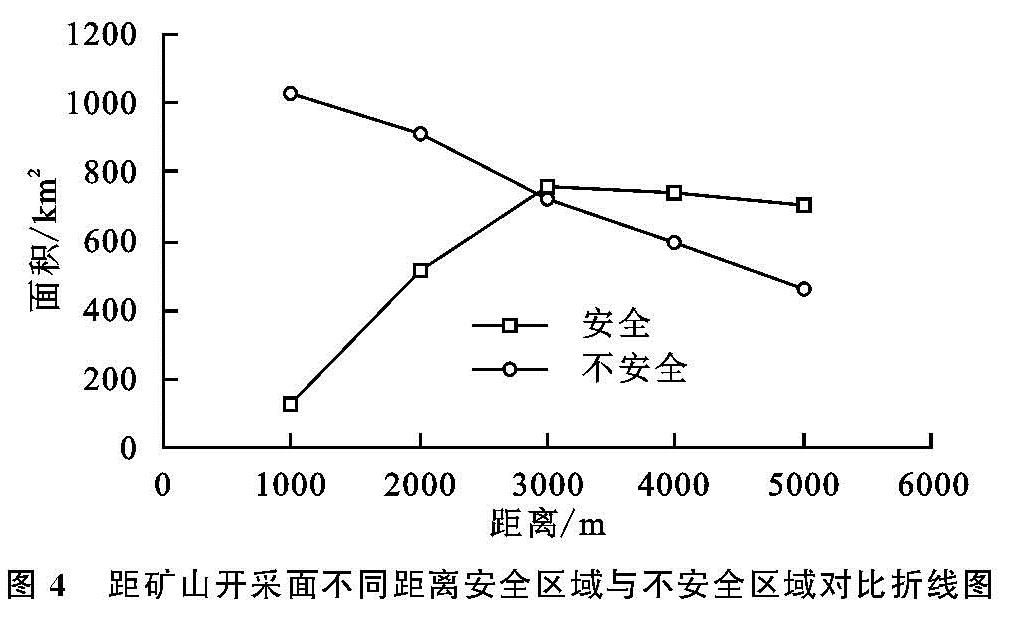1.1 研究区概况
北回归线是一条具有特殊地理学、天文学意义的假想纬度线,研究以北回归线穿越的云南省5个州市17个县(图1)为研究区,区位条件独特,西与缅甸相接,东与广西壮族自治区百色市相邻,南与越南、老挝相毗邻,地理坐标范围为22°40'50″—24°10'40″N,98°48'00″—106°11'30″E,面积约54 047.95 km2。截至2018年底,区内总人口数达829 269 106人,平均气温19℃,年平均降雨量1 214.73 mm,总计矿权面积2 613.32 km2。纵观全球北回归线所到之处多为沙漠与草原地带,唯独经过中国境内气候宜人、河流湖泊纵横交错、植被林密,生态环境优良,物产富饶,水汽充沛,素有“神奇的回归绿带”之称[30]。但是由于近年来随着城市经济的不断发展以及对于非金属类资源需求的不断增加,在矿产资源的不断开采过程中,随之也带来了严重的水体污染与生态环境的急剧破坏,大量的尾矿资源以及工业三废的排放造成了不同程度的自然景观破坏,环境污染,诱发地质灾害等问题,直接威胁和破坏人居环境,加速生态环境的恶化。有必要开展生态安全评价,以为区域的可持续发展与旅游大健康产业的发展提供科学决策依据与指导方针。
1.3 研究过程与方法
采用GIS技术平台对遥感数据经过几何纠正、空间配准、正射校正等操作后采用人工目视解译法和面向对象的影像分类法相结合对区域内的矿山生态环境、矿业活动状况信息进行遥感调查与分析,并结合已有资料进行验证和野外查证,全面研究区域内的矿山生态环境问题、形成机理及矿产资源开发状况,进而分析矿山生态环境与各自然环境、社会经济要素的空间耦合性。
1.3.1 基于DPSIR-EES框架模型建立评价指标体系 DPSIR概念模型的优点是可以很好地表达整个生态系统各因素之间的相互因果关系,但是却无法很好地反映除因果关系之外的其他内部联系; EES(Environment-Economic-Society)概念模型是包含了环境、经济、社会多要素属性的系统综合模型,但是无法反映生态系统各因素之间的因果关系。因此本研究参照吕广斌等[2]学者的研究成果,将DPSIR概念模型和EES概念模型的长处进行结合形成DPSIR-EES组合的概念模型,在此概念模型基础之上引入矿山开采状况因素将生态安全评价作为总目标层,并将其分解为驱动力、压力、状态、影响、生态响应5个准则层,每个准则层从环境、经济、社会3个要素层面结合研究区实际客观情况以及前人的相关研究文献选取相应的指标层最终形成北回归线(云南段)生态安全评价指标体系。其中环境要素主要反映影响当前生态安全的自然状况、环境条件; 经济要素则是通过研究区内各行政单元的经济发展水平、人均收入、产业支出等指标构成; 社会要素反映的是当前社会不断发展对于资源的迫切需要对生态环境产生压力的相关指标。在指标的选取过程中主要依据前人的相关文献研究成果[2,31]以及HJ651-2013《矿山生态环境保护与恢复治理技术规范(试行)》和研究区域的实际客观情况。研究所选取的指标能够很直观的反映出研究区域内自然条件现状、社会经济建设与发展状况、土地利用与植被覆盖特征、人类工程活动分布以及矿产资源开采情况等,所选取的每一指标均与研究区域内的经济、环境、社会三要素密切相关,从而更好地呈现出北回归线(云南段)当前的生态安全状况特征。
1.3.2 评价指标标准化处理 由于生态安全评价指标来源于多个方面,涉及的统计口径以及量纲并不统一,相互指标之间不具备可比性。即使同一指标之间虽然可以根据实际数值的大小来判断它对生态环境影响的程度,但是依然缺失一个合理客观的参考标准来反映其实际的影响指数。因此,在进行综合评价之前需要分别对各个评价指标进行逐一分级和标准化处理,以期消除量纲的影响。对于定量描述的指标,参照DZ/T0312-2018 《非金属矿行业绿色矿山建设规范》、GB15618-2008《土壤环境质量标准(修订)》、HJ651-2013《矿山生态环境保护与恢复治理技术规范(试行)》等国家标准和规范以及相关统计资料、研究文献进行分级; 对于定性描述的指标则通过专家咨询法向行业内的知名专家学者进行问卷咨询以及该指标对生态环境安全的影响程度、关联性为依据进行分级[32]。
对于分级后的正向指标采用如下公式进行标准化处理:
Xij=(Xi-Xmin)/(Xmax-Xmin)
对于分级后的负向指标采用如下公式进行标准化处理:
Xij=(Xmax-Xi)/(Xmax-Xmin)
式中:Xij为指标i转换后的无量纲化值; Xi为指标i标准化前的原始值; Xmax为指标i在区域中的最大值; Xmin为指标i在区域中的最小值。
1.3.3 评价指标权重计算 权重的赋值方法分为主观、客观两种,层次分析法是众多主观赋权法中常用的一种,通过对同一层级的指标进行两两比较构建判断矩阵,通过求出该判断矩阵的最大特征根和特征向量通过一致性检验后得到评价指标的权重; 该方法的优势在于能够充分反映行业领域内相关专家的经验以及实地的客观情况,但是同时也有极大可能存在受主观因素影响而夸大或降低指标的影响作用。熵值法则是根据评价指标原始固有的信息值构建判断矩阵进行指标权重计算的客观赋权方法,可以不受外界人为因素的干扰进而很好地避免由于一些主观原因带来的不稳定结果[33]。因此本文参照前人研究成果,将层次分析法与熵值法两者相互结合以实现优势互补,取偏好系数μ=0.5得到评价指标的综合权重(表2)。
1.3.4 评价模型的建立 对于解决生态安全、资源环境承载力评价研究等这种多准则问题ArcGIS的加权叠加工具应用较为广泛,将生态安全评价目标层定义为问题,各指标层分解为子模型,采用线性加权求和函数法将所有指标乘以各自的权重之后进行加和叠加得到北回归线(云南段)生态安全评价目标层的分值,然后运用自然间断点法对评价结果进行分级,分值越低,生态安全状况越好,分值越高,生态状况越不安全。所得结果科学客观,评价过程有效易操作,能够充分反映出各项指标与生态安全之间的密切联系,有利于评价结果的分析与讨论。计算公式如下:

式中:Wi表示目标层的指标值; Xi表示各指标层的权重; Yi表示指标层的评价指标因子; n为因子项数。
